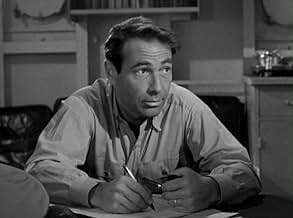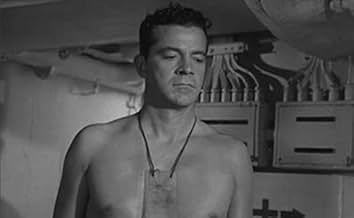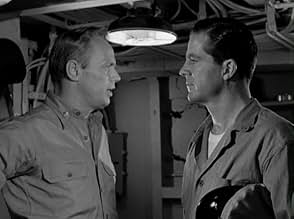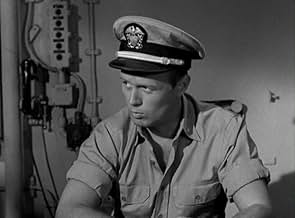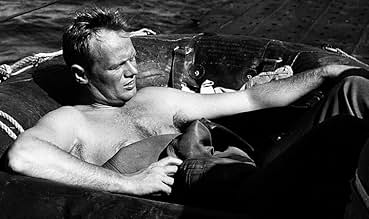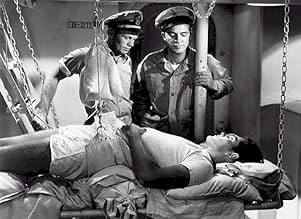Ajouter une intrigue dans votre langueThe new commander of a Navy Underwater Demolition Team--nicknamed "Frogmen"--must earn the respect of the men in his unit, who are still grieving over the death of their former commander and... Tout lireThe new commander of a Navy Underwater Demolition Team--nicknamed "Frogmen"--must earn the respect of the men in his unit, who are still grieving over the death of their former commander and resentful of the new one.The new commander of a Navy Underwater Demolition Team--nicknamed "Frogmen"--must earn the respect of the men in his unit, who are still grieving over the death of their former commander and resentful of the new one.
- Réalisation
- Scénario
- Casting principal
- Nommé pour 2 Oscars
- 1 victoire et 3 nominations au total
- Chief Ryan
- (non crédité)
- Dr. Ullman
- (non crédité)
- Ferrino
- (non crédité)
- Crew Member
- (non crédité)
- Crew Officer
- (non crédité)
- Kinsella
- (non crédité)
- Chief Petty Officer Lane
- (non crédité)
- Gunner
- (non crédité)
Avis à la une
Apart from the technical aspects of the film, the plot itself is somewhat formulaic but interesting. Richard Widmark plays the typical hard-as-nails commanding officer and naturally the men miss their old C.O. since he was "one of the boys" (see THE FLYING LEATHERNECKS and TWELVE O'CLOCK HIGH and you'll see what I mean). The whole "loneliness at the top" angle has been done many times before, though this one was played a bit better. Having such pros as Dana Andrews, Jeffrey Hunter and Gary Merrill on hand sure didn't hurt! What did hurt, however, with the formula was that, at times, it made the men seem like whiners.
Overall, rather exciting and well worth seeing despite its roots in Hollywood formula and a fitting tribute to some incredibly brave men.
Widmark begins by rubbing his men the wrong way because of their devotion to his predecessor, with Dana Andrews as his chief antagonist (especially after the former opts to leave the latter behind during a reconnaissance operation). At one point, however, Andrews has to take over a mission when Widmark becomes indisposed (where the former’s lack of responsibility leads to serious injuries sustained by one of the men); eventually, the two acquire a mutual respect – which occurs when a torpedo fired at the ship by the enemy fails to explode and has to be delicately dismantled.
The latter sequence is one of four suspense/action set-pieces in the film: the others being the two underwater missions themselves and the trial run for the first operation mentioned above. The supporting cast is led by Gary Merrill (acting as, more or less, the voice of conscience) and Jeffrey Hunter (as a brash young member of the team); also appearing, in unbilled roles, are subsequent favorite character actors James Gregory and Jack Warden.
However, the project was obviously a heart-felt effort to capture, in detail, life aboard a WWII vessel, the procedures, the politics, and the rather fascinating methods and exploits of early UDTs, and that's what makes the film stand out. What you get is (I'm guessing) a pretty accurate representation of naval special forces in WWII, and it is quite interesting to watch how a team would covertly get in and out of shallow water near a beach to plant explosives and do recon, while being heavily shelled, often with nothing on them besides swim trunks, flippers and goggles! There are also a few very good, tense scenes. (the scene where their explosives expert has to disarm a torpedo with a tongue depressor is particularly nice-- expresses all the emotion and tension of such a moment without forcing it with a dramatic score).
Recommended to anyone interested in war history, or who enjoys a nicely crafted war movie.
A standard plot is redeemed by fine performances from all, and by exciting action sequences that have not dated as much as one might suspect they would have by 2003.
The acting is outstanding and very real, especially to be so good that an old man like myself, remembers how I felt all the times I saw the film. If a film and the men involved in telling the tale of "The Frogmen" left that much impression and remembered to this day, then it had to be great acting, direction and favorably produced. There was no outlandish computer graphic techniques of today nor scenes of blowing up the world that come so common place in todays action genra films, but a reason and purpose for the gritty life and death struggle each man faced to become a frogman in the U. S. Navy or UDT (Underwater Demolition Teams) as they were and are called.
This black and white picture was dominated by the snarling Richard Widmark in perhaps his best performance in his career. I know many remember him for other films, but to me, he made this film and was the quintessential commander training his men to do a very difficult job with nothing more than shear strength of character and leadership. They did not have the high tech apparatus of todays Seals, but for what they lacked in equipment they more than made up for in "guts and glory" beneath the waters.
The rest of the cast, Dana Andrews, Gary Merrill, Jeffrey Hunter and Robert Wagner, just to name a few seemed to be portraying what is best in the Navy and men of war. Several more gave memorable performances in telling the tale of "The Frogmen" and the U. S. Navy's dedication to the finest in warfare.
The standard war movie is one thing, but this is a classic not seen much today and one in which many that followed learned by this tale of the U. S. Navy.
Le saviez-vous
- AnecdotesThe Underwater Demolition Team, the frogmen in the film, belong to is UDT-4 (some members of the team wear utility jackets with artwork of a large number "4" and a shark on the back). The real UDT-4 in World War II saw combat in the invasions of Okinawa, Saipan, Guam, and the Philippines. Like the fictional team in the film, the UDT-4 had one of their boats hit and sunk by Japanese fire at Leyte, and left a sign on the beach at Guam to welcome the invading Marines.
- GaffesThe triple-tank aqualungs used by the UDT frogmen during the film's climactic mission are incorrect for the WWII period. Although 'Jacques Cousteau', an officer in the French Navy, was working with experimental aqualungs near the end of WWII, U.S. Navy Underwater Demolition Teams did not have them during the war. Re-breathers, which had filters to trap carbon dioxide, were in use during this time period. Modern SEAL type units still use re-breathers because they produce no bubbles which can attract unwanted attention like they did in the movie. The Japanese divers in the movie had bubble-less re-breathers.
- Citations
Lt. Cmdr. Pete Vincent: Looks like you've got what amounts to a legal mutiny on your hands.
- ConnexionsReferenced in Junior (1985)
Meilleurs choix
- How long is The Frogmen?Alimenté par Alexa
Détails
- Durée1 heure 36 minutes
- Couleur
- Rapport de forme
- 1.37 : 1
Contribuer à cette page



